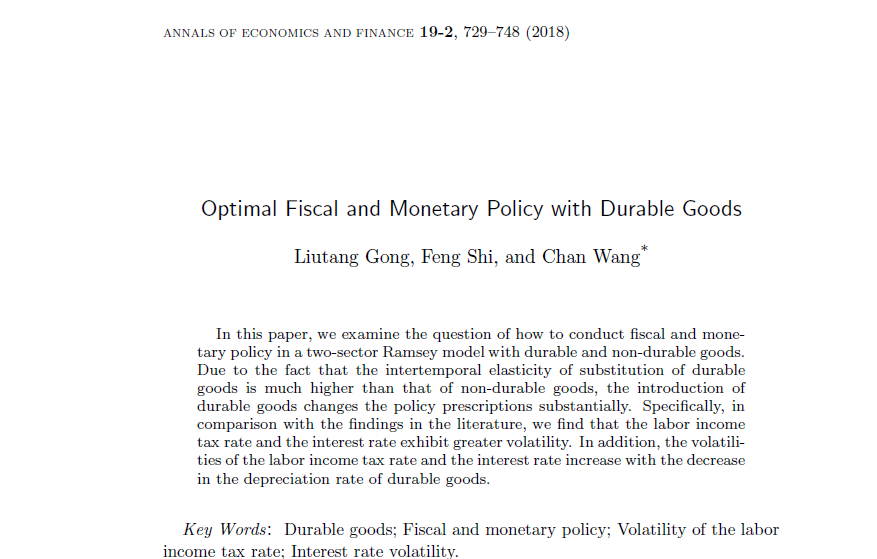Xian GU:Does Economic Structure Determine Financial Structure?
Xian GU
Journal of International Economics
Volume 114, September 2018, Pages 389-409
About the author

Xian GU, associate professor of the School of Finance at CUFE, master’s supervisor, Doctor of Economics. For more information, please visit this webpage: http://ensf.cufe.edu.cn/szdw/fjs/105687.htm
Abstract:
In this paper, we examine the relationship between the structure of the real economy and a country's financial system. We consider whether the development of the real economic structure can predict the direction of evolution of a country's financial structure. Using data for 108 countries, we find a significant relationship between real economic structure and financial structure. Next, we exploit shocks to the economies in India, Finland and Sweden, and South Korea and show that changes in the economic structure of a country influence the evolution of its financial system. This suggests that financial institutions and capital markets change in response to the structure of industries.
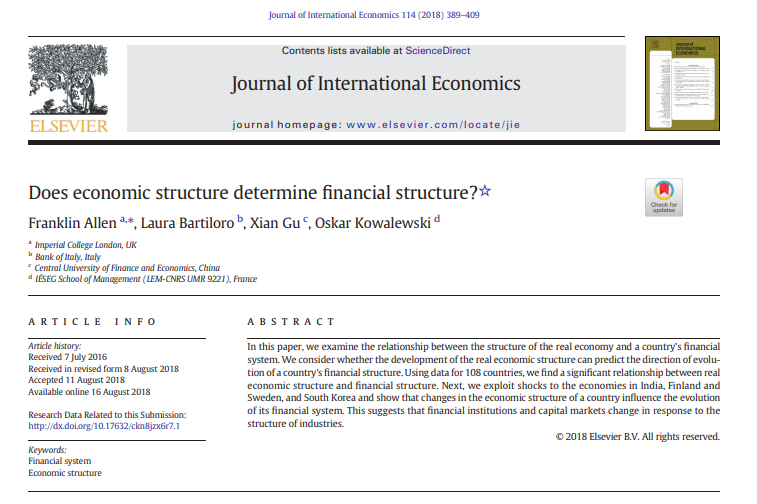
Wuyue YOU:Women’s Political Participation and Gender Gaps of Education in China: 1950–1990
Wuyue YOU
World Development
Volume 106, June 2018, Pages 220-237
About the author

Wuyue YOU, assistant professor of the School of Finance at CUFE. For more information, please visit this webpage: http://ensf.cufe.edu.cn/szdw/lecturer/105314.htm
Abstract:
Does women’s political participation have long-lasting impacts on gender equality? Using female membership in the Chinese Communist Party (CCP) as a measure for women’s political participation and relying on data provided by Chinese county chronicles, we show that female political participation in 1950 had a long-term and positive impact on gender equality of education in 1990. Relying on individual-level data provided by the 1990 census, we construct a panel dataset comprising of people of different age cohorts in individual counties and find that contemporary women’s political participation significantly narrows the gender gap by raising girls’ probability of enrollment and completion of school relative to those of boys. The positive effects remain when we use the time of “liberation”, i.e., the time when the CCP got control of a county, to construct an instrument for the female party membership in 1950 and future periods. These effects also remain significant when the period of Cultural Revolution is studied. Finally, we test two channels, the policy channel and the perception channel, by which these effects were possibly exerted. For the policy channel, public spending on education is studied; and for the perception channel, parents’ aspiration and investment for daughters’ education are studied. The paper finds supporting evidence for the perception channel, but not for the policy channel.
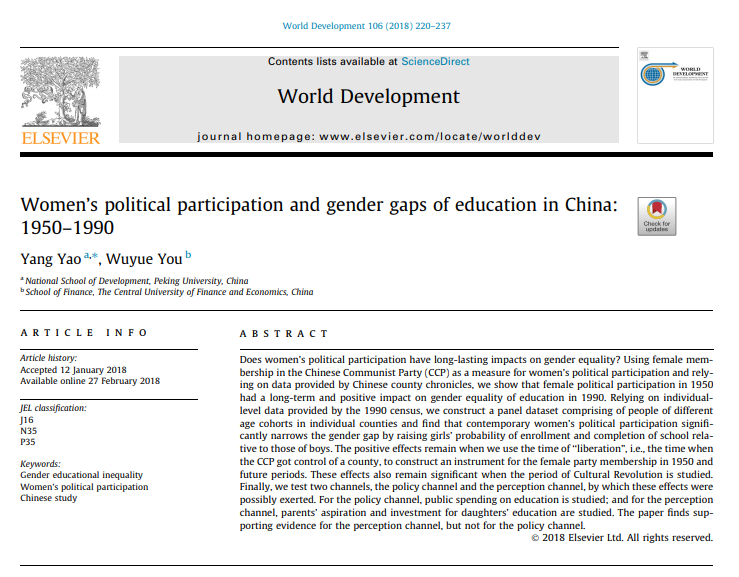
Zhi SU, Libo YIN:Oil Prices and News-based Uncertainty:Novel Evidence
Zhi SU, Libo YIN
Energy Economics
Volume 72, May 2018, Pages 331-340
About the authors

Zhi SU, professor of the School of Finance at CUFE, doctoral supervisor, Doctor of Economics. For more information, please visit this webpage: http://sam.cufe.edu.cn/info/1115/1899.htm
Libo YIN, associate professor of the School of Finance at CUFE, Doctor of Management. For more information, please visit this webpage: http://ensf.cufe.edu.cn/szdw/fjs/92565.htm
Abstract:
In this paper, using news implied volatility (NVIX) as a key variable to measure news-based uncertainty, we investigate whether the world price of oil and three classical oil shocks affect news-based uncertainty, or vice versa. Our analysis is conducted through the news mechanism that is unrelated to fundamentals. This research contributes to the literature on the effect of oil prices on news-based uncertainty by studying the dynamics, in both the time and frequency domains, using the wavelet coherence analysis. Our results illustrate that oil prices exhibit a statistically and economically significant leading role on NVIX, especially in the long run. Further, we distinguish the different impacts of oil shocks and find that the oil supply and aggregate demand shocks usually play a leading role on relatively long-term NVIX while the oil specific demand shocks are sensitive to the fluctuations of NVIX. We also find that the rules of comovement between oil prices (oil shocks) and news-based uncertainty change at different frequencies and times. They usually move together in opposite directions with the exception of the oil supply shocks and NVIX. These findings apply to both oil spot and futures markets. Our results present new and interesting implications for investors and policy makers by supporting the news reallocation channel as an important transmission mechanism from oil markets.
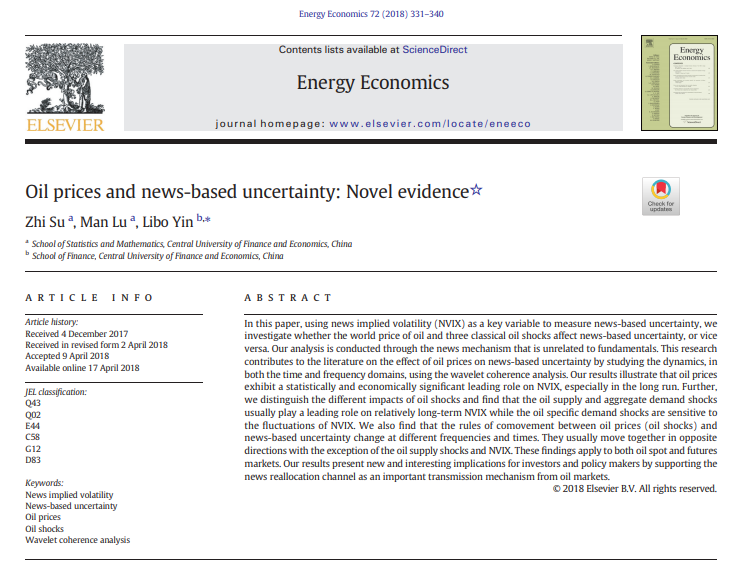
Libo YIN:Investor Attention and Currency Performance: International Evidence
Libo YIN
Applied Economics
VOL. 50, NO. 23,2018, Pages2525–2551
About the author

Libo YIN, associate professor of the School of Finance at CUFE, Doctor of Management. For more information, please visit this webpage: http://ensf.cufe.edu.cn/szdw/fjs/92565.htm
Abstract:
This article investigates the relationship between investor attention measured by Google search volume index and the performance of several currencies. We find that currency performance is remarkably responsive to changes in investor attention. These impacts, generated rapidly, are present over the relatively long term, especially for emerging currencies, and are intensified during periods of high uncertainty. We also demonstrate that there is a prominent asymmetric effect for the impact of attention, as past currency performance also influences attention. Typically, past currency performance can determine the magnitude of the impact on current currency performance. Moreover, we confirm that investor attention has a predictive power for forecasting emerging currency performance in the out-of-sample analysis. Further, these forecasts generate substantial economic value in the framework of asset allocation. By contrast, statistical predictability and economic value do not exist in the currencies from developed markets. These results indicate that investor attention can alter currency performance and its predictability. More broadly, our study emphasizes the potential of employing investor attention for emerging currency performance forecasting applications.
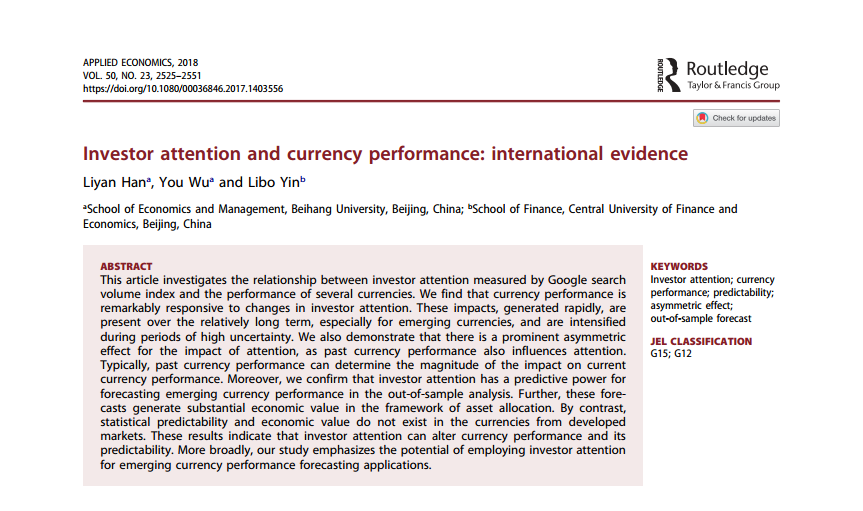
Rui CHEN:Rational Expectations, Difference of Opinions and Asset Pricing
Rui CHEN
Applied Economics
Volume 50, 2018 - Issue 31
About the author

Rui CHEN, associate professor of the School of Finance at CUFE, Doctor of Finance. For more information, please visit this webpage: http://ensf.cufe.edu.cn/szdw/fjs/105683.htm
Abstract:
This article applies the concept of relative overconfidence (the measure of how heavily investors depend on others’ information) to combine the rational expectations equilibrium (REE) and difference of opinions (DO) models. And we discuss the effects of relative overconfidence on asset price efficiency and trading volume. We find that when investors hold assets to maturity, relative overconfidence has no effect on price efficiency and trading volume; however, when investors speculate, relative overconfidence reduces price informativeness and trading volume, because investors will reckon asset prices as more noisy and find it meaningless to speculate on capital gains based on their private information. Our results highlight the role of speculation in differentiating REE and DO models and influencing the effects of overconfidence.
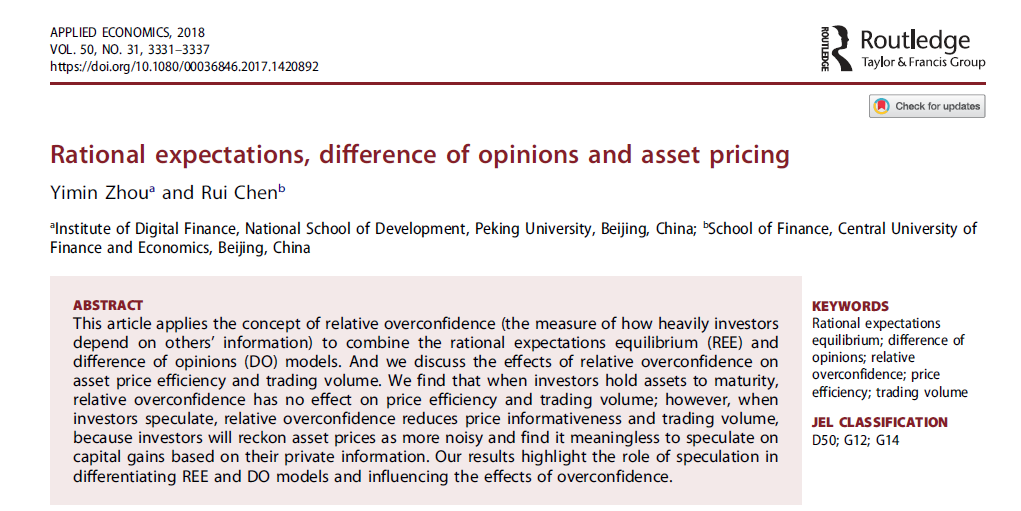
Libo YIN:Our Currency, Your attention: Contagion Spillovers of Investor Attention on Currency Returns
Libo YIN
Economic Modelling
About the author

Libo YIN, associate professor of the School of Finance at CUFE, Doctor of Management. For more information, please visit this webpage: http://ensf.cufe.edu.cn/szdw/fjs/92565.htm
Abstract:
This study investigates financial contagion among currency markets through the novel channel of investor attention measured by Google search volume index (SVI). These contagion spillovers, generated rapidly, are mainly positive and relatively short-lived. The effects are more remarkable for lagged currency attention from developed markets on emerging currency returns. Besides, the effects are barely affected by additionally controlling for liquidity, which means that investor attention plays an indispensable role in financial contagion. Additionally, past currency appreciation negatively impacts contagion spillovers of attention on present currency returns. Hence, increased attention diminishes the return predictability and therefore alleviates market inefficiency. Furthermore, we corroborate that investor attention provides a statistically significant out-of-sample forecast on currency returns, which is congruent with the previous in-sample results. Overall, our findings support the attention reallocation channel as an important contagion mechanism among currency markets and show that attention works as a predictive variable.
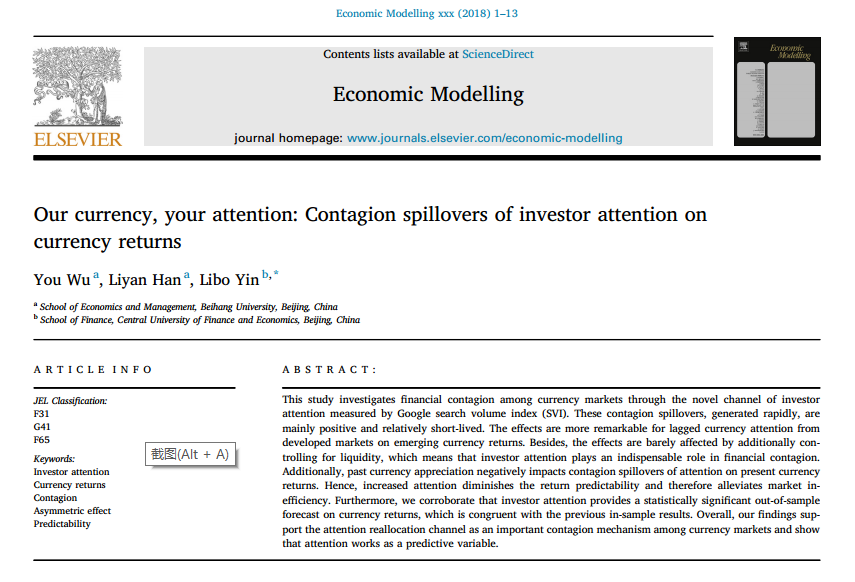
Zhi SU, Libo YIN:Understanding Stock Market Volatility: What is the Role of U.S. Uncertainty?
Zhi SU, Libo YIN
The North American Journal of Economics and Finance
Available online 1 August 2018, In Press
About the authors

Zhi SU, professor of the School of Finance at CUFE, doctoral supervisor, Doctor of Economics. For more information, please visit this webpage: http://sam.cufe.edu.cn/info/1115/1899.htm
Libo YIN, associate professor of the School of Finance at CUFE, Doctor of Management. For more information, please visit this webpage: http://ensf.cufe.edu.cn/szdw/fjs/92565.htm
Abstract:
This study investigates the spillover of U.S. economic uncertainty on the stock market volatility of six industrialized and three emerging-market countries, using a bivariate GARCH-MIDAS model. We consider three different U.S. uncertainty indices: economic policy uncertainty (EPU), financial uncertainty (FU), and news implied uncertainty (NVIX). Our results indicate that EPU is positively associated with the industrialized countries’ stock market volatility; FU does not appropriately predict long-term stock market volatility; and NVIX is the more powerful predictor of market volatility, with higher NVIX leading to lower volatility. Our study highlights a new channel of market contagion and furthers our understanding of the sources of stock market volatility.
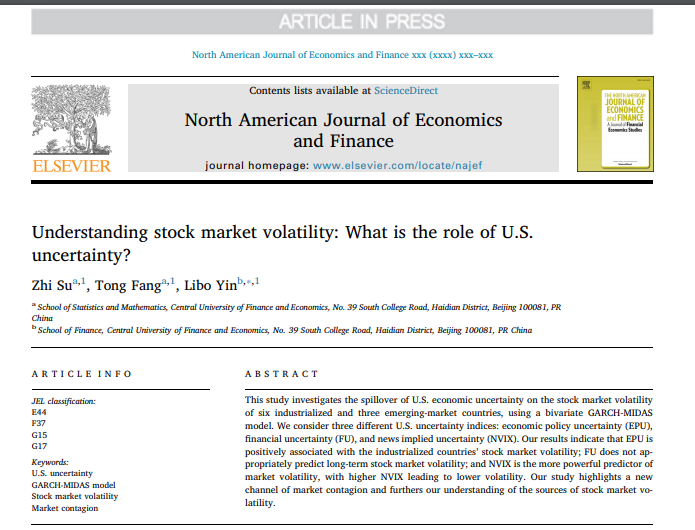
Libo YIN:Can Investors Attention on Oil markets Predict Stock Returns?
Libo YIN
North American Journal of Economics and Finance
About the author

Libo YIN, associate professor of the School of Finance at CUFE, Doctor of Management. For more information, please visit this webpage: http://ensf.cufe.edu.cn/szdw/fjs/92565.htm
Abstract:
This paper sets out to explore the predictability of the U.S. equity risk premium directly based on investor attention to oil. We find that the predictive power of oil attention exhibits statistical and economic significance within different models in both in-sample and out-of-sample tests. Meanwhile, oil attention reveals considerable and robust economic value for asset allocation in the sense of positive utility gains. Furthermore, supportive evidence that oil attention is closely linked to stock market volatility endues it with a macroeconomic meaning, serving as an explanation for its predictive power. Overall, investor attention to oil does have a direct predictive power to forecast the U.S. stock excess returns.
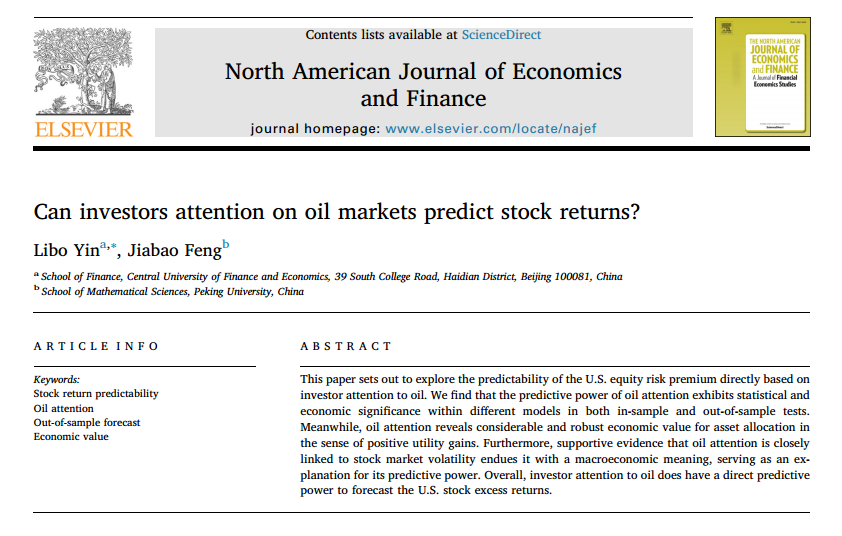
Libo YIN:Can Skewness Predict Currency Excess Returns?
Libo YIN
North American Journal of Economics and Finance
About the author

Libo YIN, associate professor of the School of Finance at CUFE, Doctor of Management. For more information, please visit this webpage: http://ensf.cufe.edu.cn/szdw/fjs/92565.htm
Abstract:
This paper investigates whether the skewness of returns is informative about future currency excess returns. We first conduct portfolio-level analyses with and without control variables, such as volatility, liquidity and global foreign exchange (FX) volatility risk. Then, we run regressions at the currency level to examine the predictive ability of skewness. The empirical results indicatea positive and significant relationship between skewness and future currency excess returns. We then compare the skewness strategy with the traditional carry trade and find that skewness still matters after excluding the effects of the carry trade. Our empirical findings are robust to subsamples (emerging, non-Euro and Group of Twenty economies) and different business cycle states. Finally, we find that skewness strategies cannot be enhanced by considering information about currency regimes.
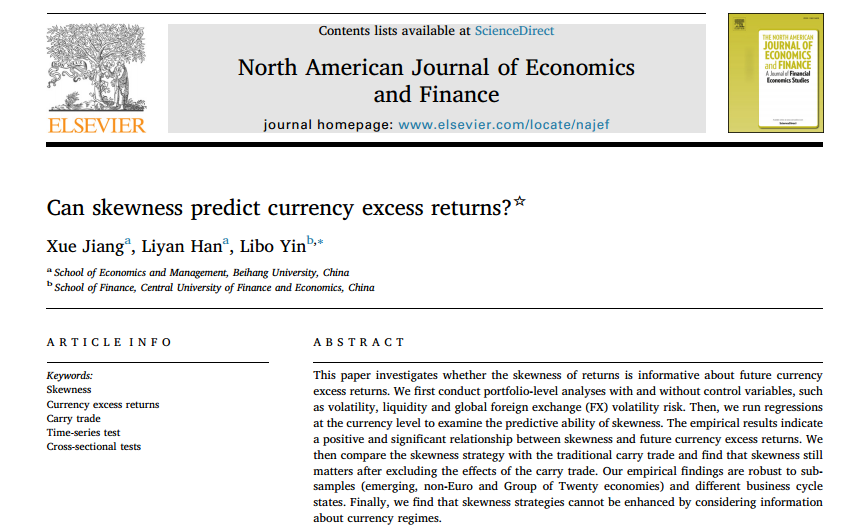
Libo YIN:Uncertainty and Currency Performance: A Quantile-on-quantile Approach
Libo YIN
North American Journal of Economics and Finance
About the author

Libo YIN, associate professor of the School of Finance at CUFE, Doctor of Management. For more information, please visit this webpage: http://ensf.cufe.edu.cn/szdw/fjs/92565.htm
Abstract:
This paper sets out to explore the predictability of the U.S. equity risk premium directly based on investor attention to oil. We find that the predictive power of oil attention exhibits statistical and economic significance within different models in both in-sample and out-of-sample tests. Meanwhile, oil attention reveals considerable and robust economic value for asset allocation in the sense of positive utility gains. Furthermore, supportive evidence that oil attention is closely linked to stock market volatility endues it with a macroeconomic meaning, serving as an explanation for its predictive power. Overall, investor attention to oil does have a direct predictive power to forecast the U.S. stock excess returns.
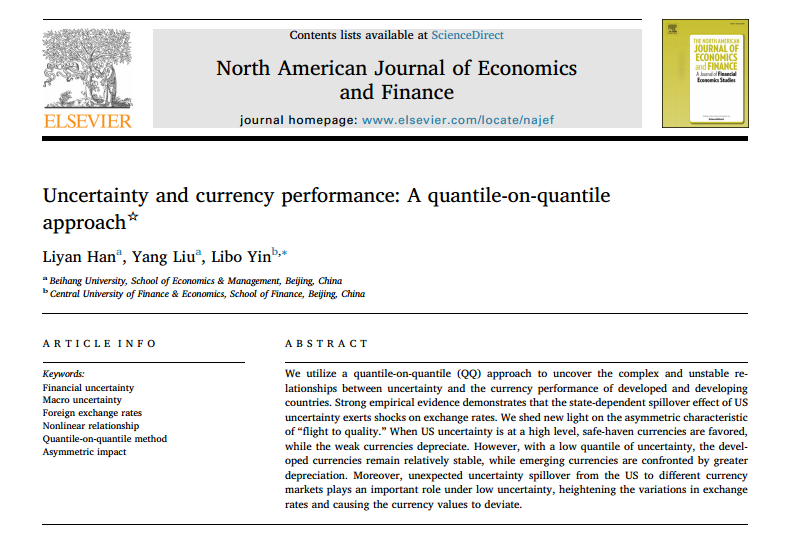
Fuwei JIANG:Q-theory, Mispricing, and Profitability Premium: Evidence from China
Fuwei JIANG
Journal of Banking & Finance
Volume 87, February 2018, Pages 135-149
About the author

Fuwei JIANG, associate professor of the School of Finance at CUFE, master’s supervisor, Doctor of Finance. For more information, please visit this webpage: http://ensf.cufe.edu.cn/szdw/fjs/92566.htm
Abstract:
Using various empirical measures, we find that, in China, firms with high profitability generate substantially higher future stock returns than those with low profitability. This positive effect of profitability on expected returns is robust to controlling for other firm characteristics and risks. We show that the profitability premium is stronger among firms with low investment friction, which is consistent with the implications of investment-based q-theory asset pricing models. However, the premium is not stronger among firms with high limits to arbitrage, contradicting behavioral mispricing explanations.
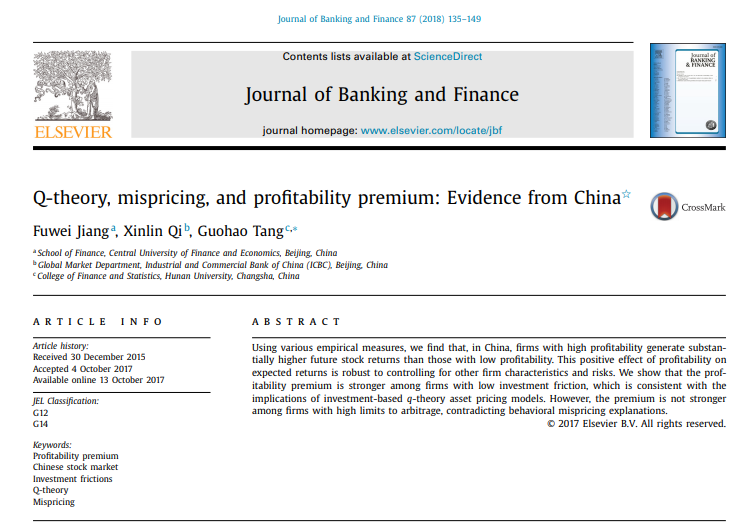
Libo YIN:Oil and the Short-term Predictability of Stock ReturnVolatility
Libo YIN
Journal of Empirical Finance
Volume47, 2018 Pages 90-104
About the author

Libo YIN, associate professor of the School of Finance at CUFE, Doctor of Management. For more information, please visit this webpage: http://ensf.cufe.edu.cn/szdw/fjs/92565.htm
Abstract:
The goal of this paper is to show that crude oil volatility is predictive of stock volatility in the short-term from both in-sample and out-of-sample perspectives. The revealed predictability is also of economic significance, as shown by examining the performance of portfolios constructed on the oil-based forecasts of stock volatility. Results from robustness tests suggest that oil volatility provides different information from traditional macro variables. Further analysis shows that simple linear regression is sufficient for capturing predictive relationships between oil and stock volatility. Oil volatility is found to predict return volatilities of a significant number of industry portfolios during recent periods.
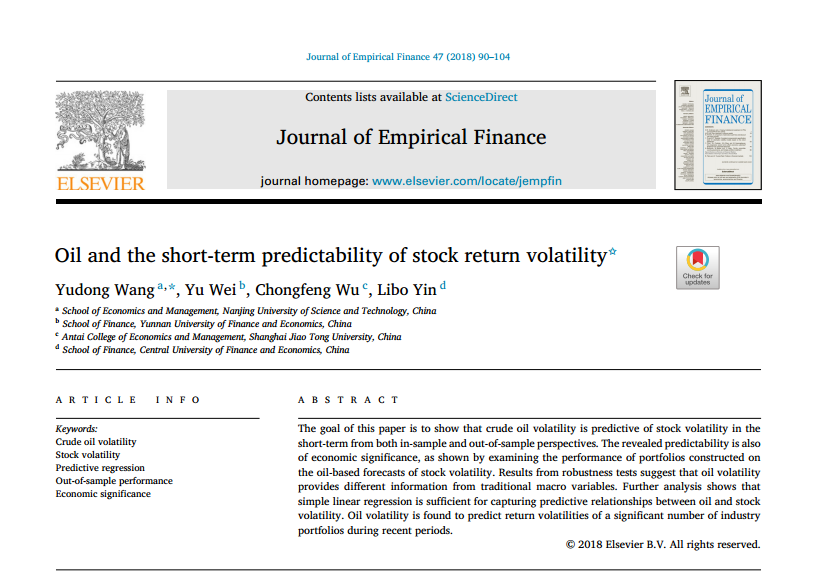
Xian GU:How Creditor Rights Affect the Issuance of Public Debt: The Role of Credit Ratings
Xian GU
Journal of Financial Stability
Volume 39, November 2018, Pages 133-143
About the author

Xian GU, associate professor of the School of Finance at CUFE, master’s supervisor, Doctor of Economics. For more information, please visit this webpage: http://ensf.cufe.edu.cn/szdw/fjs/105687.htm
Abstract:
We propose that credit ratings act as an information channel which, combined with more power being given to creditors by countries strengthening creditor rights, leads to an increase in the supply of public debt. From a firm-level dataset covering 51 developed and developing countries for 1989 through 2013, we find that in countries with stronger creditor rights, firms tend to have higher credit ratings. We confirm that in these countries, firms with higher credit ratings exhibit a greater issuance of public debt than that of equity. As further evidence that credit ratings reduce agency costs of debt, we find that improvements in creditor rights and resulting higher credit ratings increase capital expenditures among firms experiencing severe bondholder-shareholder conflicts.
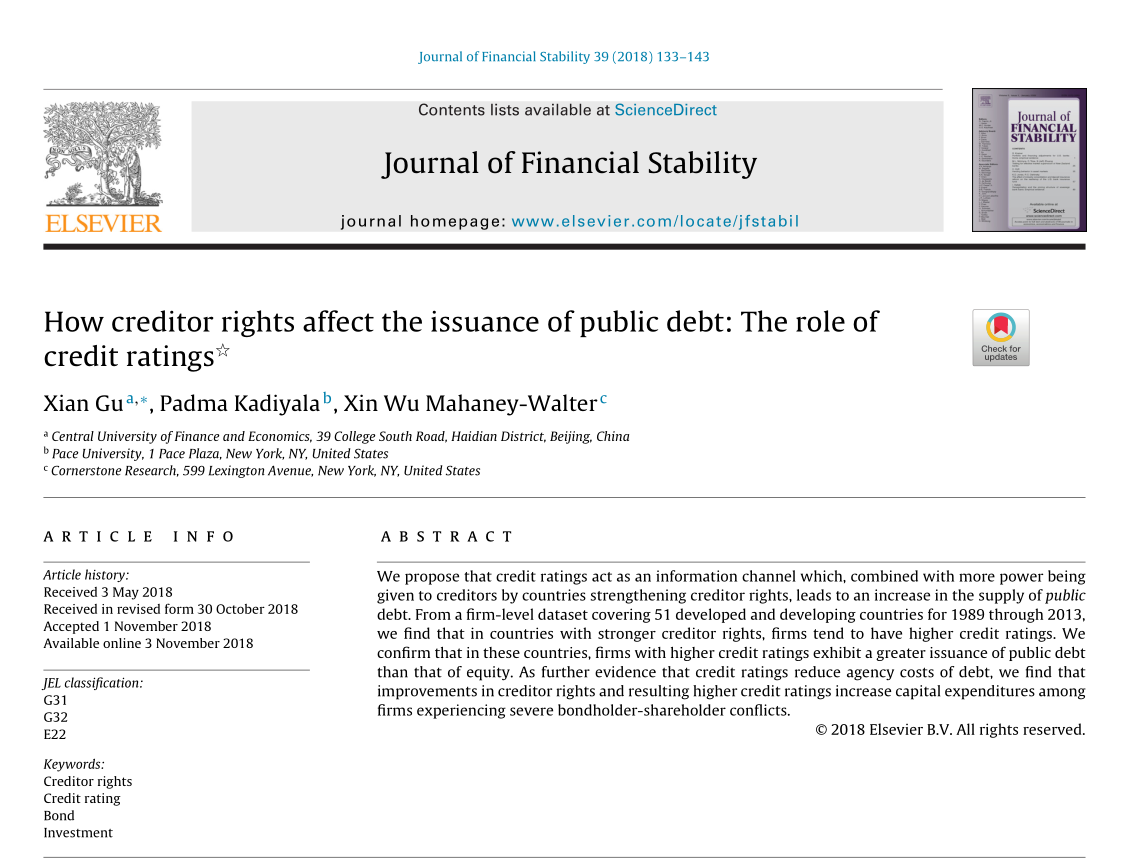
Libo YIN:Does News Uncertainty Matter for Commodity Futures Markets? Heterogeneity in Energy and Non-energy Sectors
Libo YIN
Journal of Futures Markets
Volume38, Issue10 Pages 1246-1261
About the author

Libo YIN, associate professor of the School of Finance at CUFE, Doctor of Management. For more information, please visit this webpage: http://ensf.cufe.edu.cn/szdw/fjs/92565.htm
Abstract:
This study investigates the impact of news implied volatility (NVIX) and its two sub‐components (news about stock markets, SMI, and news about banks and other financial intermediaries, FII) on the long‐term volatilities of commodity futures. Our empirical results clearly show that NVIX behaves heterogeneously in energy and non‐energy sectors. NVIX exerts a positively significant influence on volatilities of non‐energy futures. By contrast, volatilities of energy futures cannot be triggered by NVIX. We further show that SMI significantly affects both energy and non‐energy futures, whereas, FII only impacts non‐energy futures.
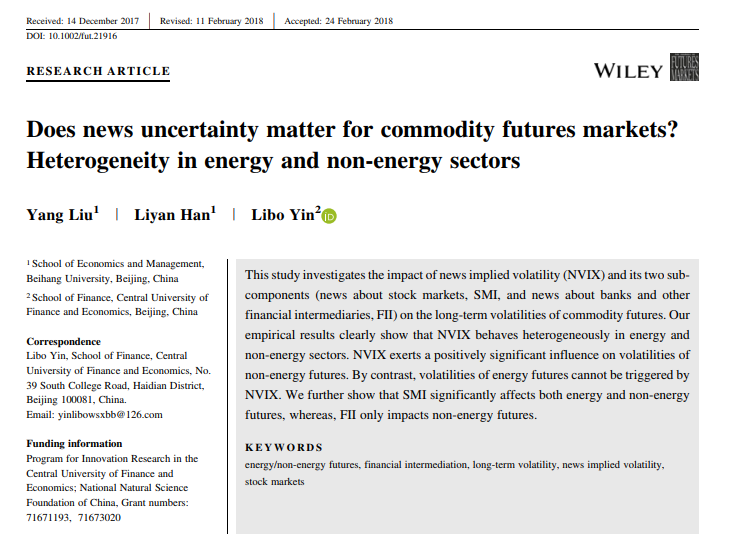
Libo YIN:Causality between Oil Shocks and Exchange Rate A Bayesian, Graph-based VAR Approach
Libo YIN
Physica A: Statistical Mechanics and its Applications
VOL. 508, 2018, Pages 434–453
About the author

Libo YIN, associate professor of the School of Finance at CUFE, Doctor of Management. For more information, please visit this webpage: http://ensf.cufe.edu.cn/szdw/fjs/92565.htm
Abstract:
Our paper studies the casual relationship between oil and major bilateral exchange rates against US dollar via a novel Bayesian, graph-based approach. This approach is shown to be quite effective in dealing with identification in Vector Auto regression (VAR) model, in which the temporal causal structure is represented by a graph sampled by Markov Chain Monte Carlo (MCMC) method. Empirical evidence demonstrates that oil price leads the exchange market in the after-crisis period whereas vice versa before crisis, implying a potential impact from financial crisis on the causality between these two markets. We further show that in general, oil-market specific shock affects the dependence structure most, while aggregate demand shock plays a weaker role and supply shock contributes least. Specifically, these three oil shocks take effect during different periods, thus capturing some invisible information about market evolutions.
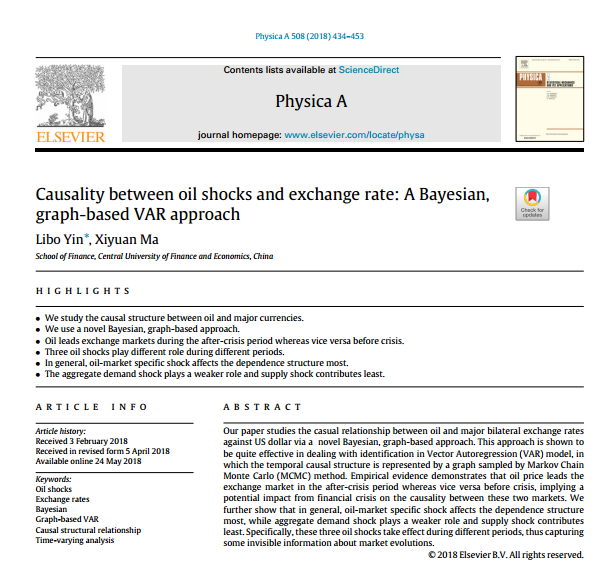
Libo YIN:Optimistic Bias of Analysts' Earnings Forecasts Does Investor Sentiment Matter in China
Libo YIN
Pacific-Basin Finance Journal
VOL. 49, 2018, Pages147–163
About the author

Libo YIN, associate professor of the School of Finance at CUFE, Doctor of Management. For more information, please visit this webpage: http://ensf.cufe.edu.cn/szdw/fjs/92565.htm
Abstract:
This paper primarily studies the effects of irrational factors (investor sentiment) on analysts’ forecast bias and the impacts of rational factors (conflicts of interest) on the sentiment-forecast bias nexus. Empirical findings show that investor sentiment does have significant positive impacts on analysts' forecast bias. This effect still holds after controlling for rational factors(commission relationship, underwriting relationship and reputation factors). Moreover, investor sentiment has more notable impacts on analysts' forecast bias for those who are under the pressure of conflicts of interest, particularly for the commission relationship. The stronger the commission relationship is, the greater the analysts' forecast bias. Our results provide new insight into the mechanism through which investor sentiment affects returns.
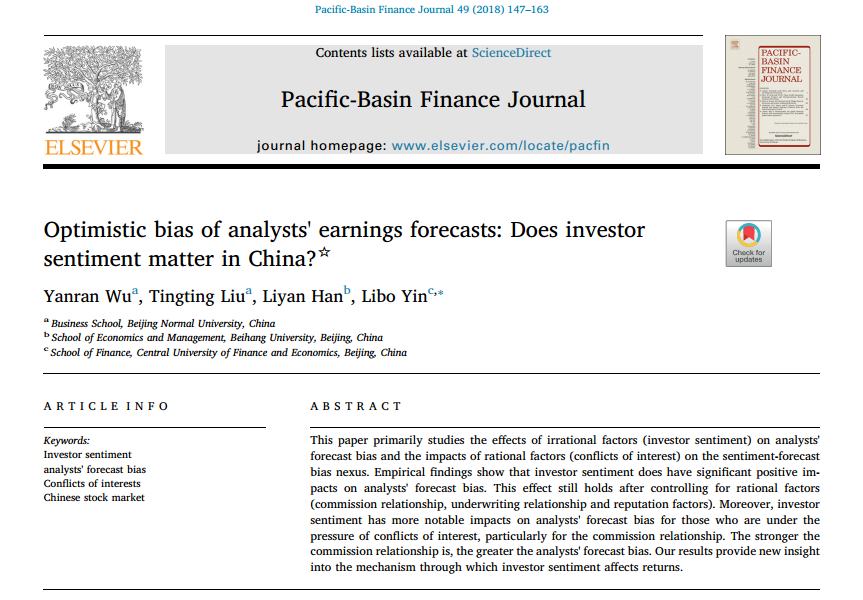
Libo YIN:Forecasting the CNY-CNH Pricing Differential: The Role of Investor Attention
Libo YIN
Pacific-Basin Finance Journal
VOL. 49, 2018, Pages232–247
About the author

Libo YIN, associate professor of the School of Finance at CUFE, Doctor of Management. For more information, please visit this webpage: http://ensf.cufe.edu.cn/szdw/fjs/92565.htm
Abstract:
As the exponential expansion in the international use of RMB, the issues concerning “one currency, two markets” have attracted increasing attentions from both policymakers and academics. We investigate the forecast power of investor attention for the CNY-CNH pricing differential. Investor attention displays statistically and economically significant in-sample and out-of-sample predictability of the CNY-CNH pricing gap at both weekly and monthly frequencies. Also, investor attention provides more useful information than macro variables for detecting the typical rise (decline) behavior near a CNY-CNH differential peak (trough). In addition, investor attention generates substantial economic values in asset allocation exercise. Moreover, we demonstrate that investor attention provides statistically and economically significant out-of-sample forecast for the CNY and CNH carry trade.

Xueyong ZHANG:Mutual Fund Managers’ Prior Working Experience and Their Investment Skills
Xueyong ZHANG
Financial Management
About the author

Xueyong ZHANG, professor of the School of Finance at CUFE, doctoral supervisor. For more information, please visit this webpage: http://ensf.cufe.edu.cn/szdw/js/92288.htm
Abstract:
This paper examines the relationship between mutual fund managers’ past professional backgrounds and their portfolio performance using Chinese mutual fund data from 2003 to 2016. We focus on managers with prior work experience either as industry analysts or as macroanalysts. We hypothesize that managers who worked as industry analysts exhibit superior stock picking skills, while managers with a background as macroanalysts time the market better. These hypotheses are supported by the data after controlling for observable fund and manager characteristics. Bootstrap analyses suggest that a significant difference in performance between these two types of managers cannot be attributed purely to luck.
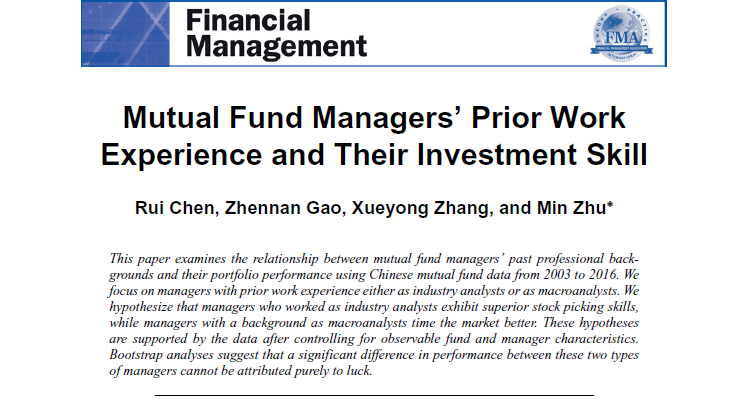
Xueyong ZHANG:The Role of Foreign and Domestic Venture Capital in Innovation: Evidence from China
Xueyong ZHANG
Accounting & Finance
About the author

Xueyong ZHANG, professor of the School of Finance at CUFE, doctoral supervisor. For more information, please visit this webpage: http://ensf.cufe.edu.cn/szdw/js/92288.htm
Abstract:
This paper analyses the different effects of foreign venture capital (FVC) and domestic venture capital (DVC) on innovation for IPOs. Using patent counts to measure innovation, the results indicate that FVC‐backed firms are less innovative than DVC‐backed firms. Our findings are robust after controlling for the sample selection bias using a propensity score matching approach. One possible underlying mechanism through which FVCs nurture less innovation is their inferior geographic proximity to investment targets.
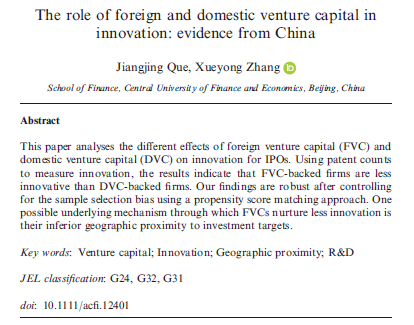
Qin GOU:Does Ownership Matter in Access to Bank Credit in China?
Qin GOU
The European Journal of Finance
2018, VOL. 24, NO. 16, 1409–1427
About the author

Qin GOU, associate professor of the School of Finance at CUFE, Doctor of Economics. For more information, please visit this webpage: http://ensf.cufe.edu.cn/szdw/fjs/105685.htm
Abstract:
Employing two World Bank survey datasets of small- and medium-sized enterprises (SMEs), we investigate whether ownership discrimination exists in Chinese banks’ credit allocation. By comparing firms’ credit demand and loan availability, we identify two types of credit-rationing, self- and bank-rationing. We find that more than half of potential borrowers are credit-rationed, most of which is due to self-rationing. While several firm characteristics and macro-financial factors are important in determining chances of credit-rationing, there is no evidence to support the popular assertion of ownership discrimination in credit allocation in China. This also suggests that ownership reform alone is not sufficient for alleviating SMEs’ funding difficulties.
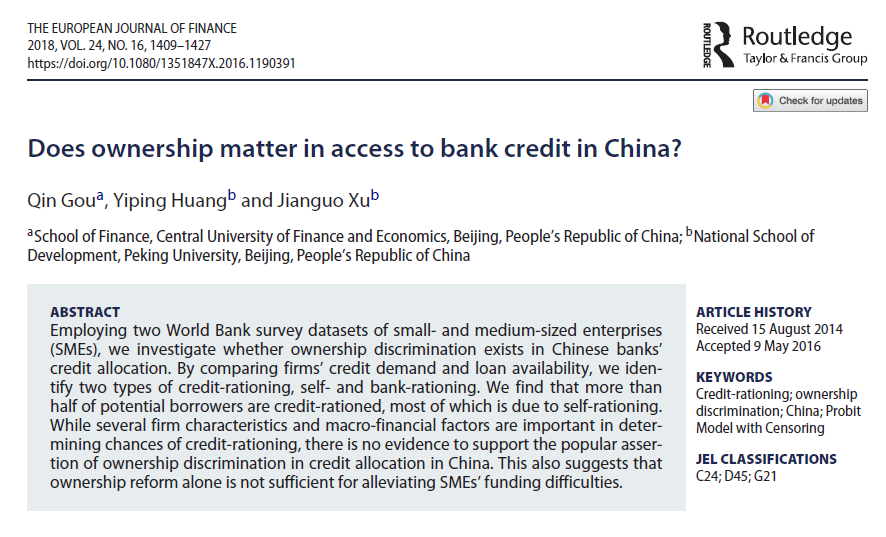
Libo YIN:Investor Attention and Stock Returns International Evidence
Libo YIN
Emerging Markets Finance and Trade
About the author

Libo YIN, associate professor of the School of Finance at CUFE, Doctor of Management. For more information, please visit this webpage: http://ensf.cufe.edu.cn/szdw/fjs/92565.htm
Abstract:
This article examines the asymmetric/discriminative effects of investor attention on expected stock returns among 15 markets through economic expansions and recessions. The predictive power of attention tends to be short-lived and weakens the autocorrelation within returns. Accounting for business cycles not only confirms that the predictability of attention endures with volatility but also explicates the asymmetric effects that underlying pessimism functions better. International evidence contributes to the literature on investor attention and reveals the discrepant effects of attention with three levels of market efficiency: semi-strong, stronger than semi-strong, and weak.
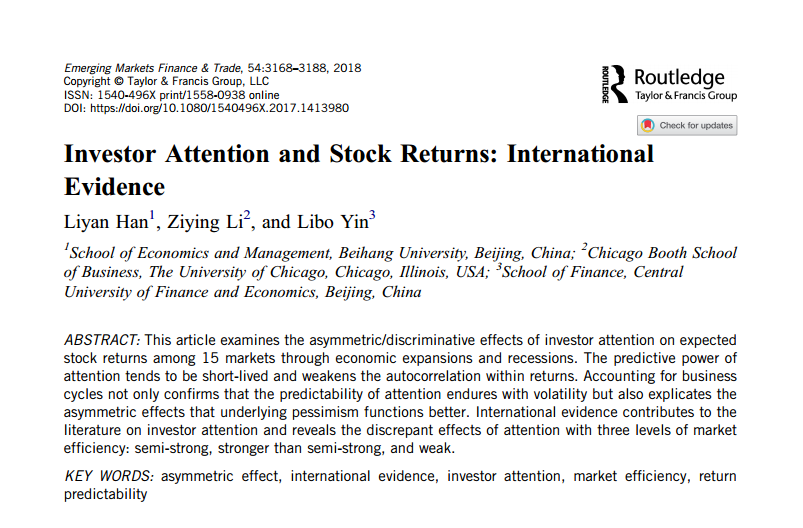
Libo YIN, Zhi SU:Common Idiosyncratic Volatility and Returns: From an Investment Horizon
Libo YIN, Zhi SU
International Journal of Finance & Economics
About the authors

Libo YIN, associate professor of the School of Finance at CUFE, Doctor of Management. For more information, please visit this webpage: http://ensf.cufe.edu.cn/szdw/fjs/92565.htm
Zhi SU, professor of the School of Finance at CUFE, doctoral supervisor, Doctor of Economics. For more information, please visit this webpage: http://sam.cufe.edu.cn/info/1115/1899.htm
Abstract:
“Idiosyncratic risk–return puzzle” is conflicting and confusing. It becomes more complex by the introduction of the common idiosyncratic volatility (CIV). We shed new light on the issue from the perspective of heterogeneity of investors with different investment horizons. We study the “CIV puzzle” with Chinese A‐Share market evidence and further contribute by employing the wavelet multiresolution analysis framework to decompose the overall CIV into timescales that refer to risks in different terms. We apply these time scales in Fama–Macbeth regressions to investigate their pricing effects. The results suggest that the “CIV puzzle” is an investment horizon specification problem. The relationship between returns and common idiosyncratic risk is negative in the short run, positive in the intermediate run, and then negative again in the longer run. We also contribute to the international empirical evidence with an in‐depth analysis of the Chinese stock market over the period 1999–2016. The results are robust across different specifications of the CIV. Our findings have important implications for portfolio and risk management.
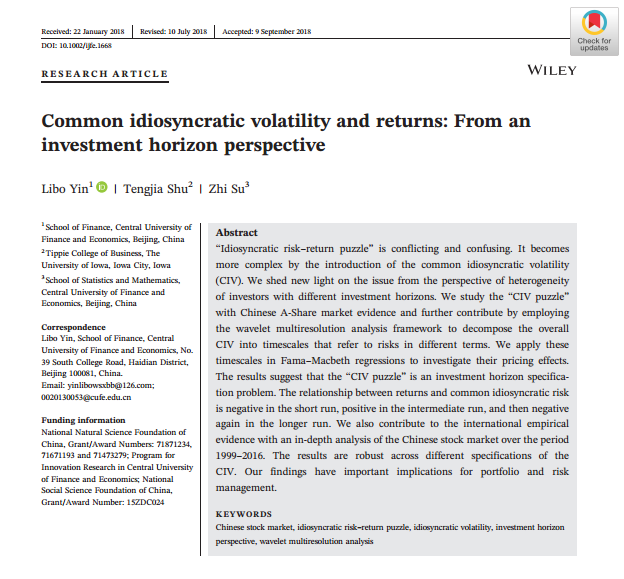
Xian GU:The Interplay between Regulations and Financial Stability
Xian GU
Journal of Financial Services Research
June 2018, Volume 53, Issue 2–3, pp 233–248
About the author

Xian GU, associate professor of the School of Finance at CUFE, master’s supervisor, Doctor of Economics. For more information, please visit this webpage: http://ensf.cufe.edu.cn/szdw/fjs/105687.htm
Abstract:
The crisis demonstrated that microprudential regulation focusing on the risks taken by individual banks is not sufficient to prevent crises. This is because it ignores systemic risk. Six types of systemic risk are identified, namely: (i) panics – banking crises due to multiple equilibria; (ii) banking crises due to asset price falls; (iii) contagion; (iv) financial architecture; (v) foreign exchange mismatches in the banking system; (vi) behavioral effects from Knightian uncertainty. We focus on the first three as they are arguably the main causes of the 2007–9 crisis and consider regulatory and other policies to counteract them.
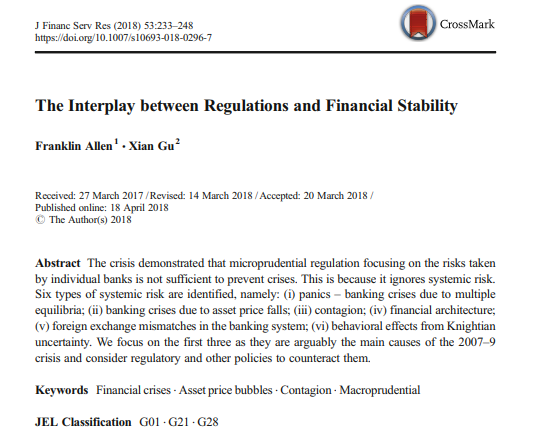
Libo YIN:The Predictive Performance of the Currency Futures Basis for Spot Returns
Libo YIN
Quantitative Finance
About the author

Libo YIN, associate professor of the School of Finance at CUFE, Doctor of Management. For more information, please visit this webpage: http://ensf.cufe.edu.cn/szdw/fjs/92565.htm
Abstract:
This paper investigates the predictive performance of the futures basis in directly forecasting currency spot returns and compares it with that of the one-month forward basis. We consider the settle prices of both front-month and nearby-month continuous futures contracts and find that the futures basis exhibits statistically and economically significant in-sample and out-of-sample forecasting power, which clearly exceeds that of the well-known forward basis. The empirical results show that spot returns correspond negatively to both the front-month futures basis and nearby-month futures basis. Furthermore, the futures basis reveals substantial economic value for investors in terms of sizable and tangible portfolio gains, which are consistent with statistical measures. The difference in the forecasting ability of the futures basis and forward basis can be explained by the level of exposure to the time-varying risk premium. Finally, we find that impacts of the futures basis on spot returns vary with time and experienced substantial structural changes during the Global Financial Crisis.
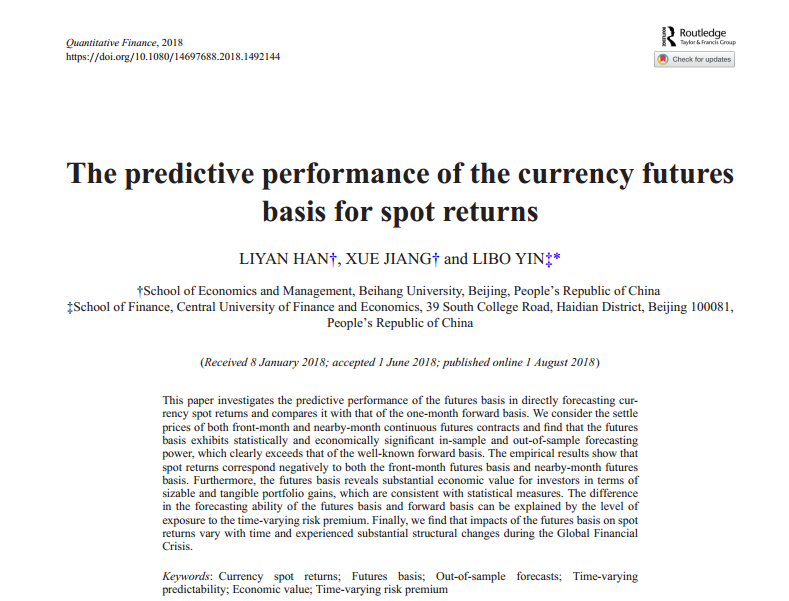
Biqiong ZHANG:Global Volatility Spillover in Asian Financial Markets
Biqiong ZHANG
Mediterranean Journal of Social Sciences
Vol 9 No2,March 2018
About the author

Biqiong ZHANG, professor of the School of Finance at CUFE, master’s supervisor, doctoral supervisor. For more information, please visit this webpage: http://ensf.cufe.edu.cn/szdw/js/23087.htm
Abstract:
The present paper accommodates the spillover impact of market volatility index of S & P 500 (VIX) and China exchange-traded fund’s volatility (VXFXI) on the emerging equity (KSE-100 index) and foreign exchange markets of Pakistan. In this context, we use a vector autoregressive (VAR) model and impulse response functions (IRF) to explore link among VIX indices and financial markets of Pakistan for the differential time periods. The study concludes that a rise in both VIX and VXFXI results in price falls of KSE-100 index and deteriorates exchange rate market. This implies that VIX act as ‘fear gauge’ on both stock and exchange rate markets in Pakistan. These outcomes provide an imperative implication on the pattern of currency and stock sensitivities against global volatility. This reveals that adverse movements in global volatility in the USA and Chinese financial market have a significant impact and a rise in VIX causes an outflow of investment from financial markets of Pakistan. Moreover, our results may guide local and global investors to anticipate the potential direction of stock and exchange rate markets based on market volatility index.
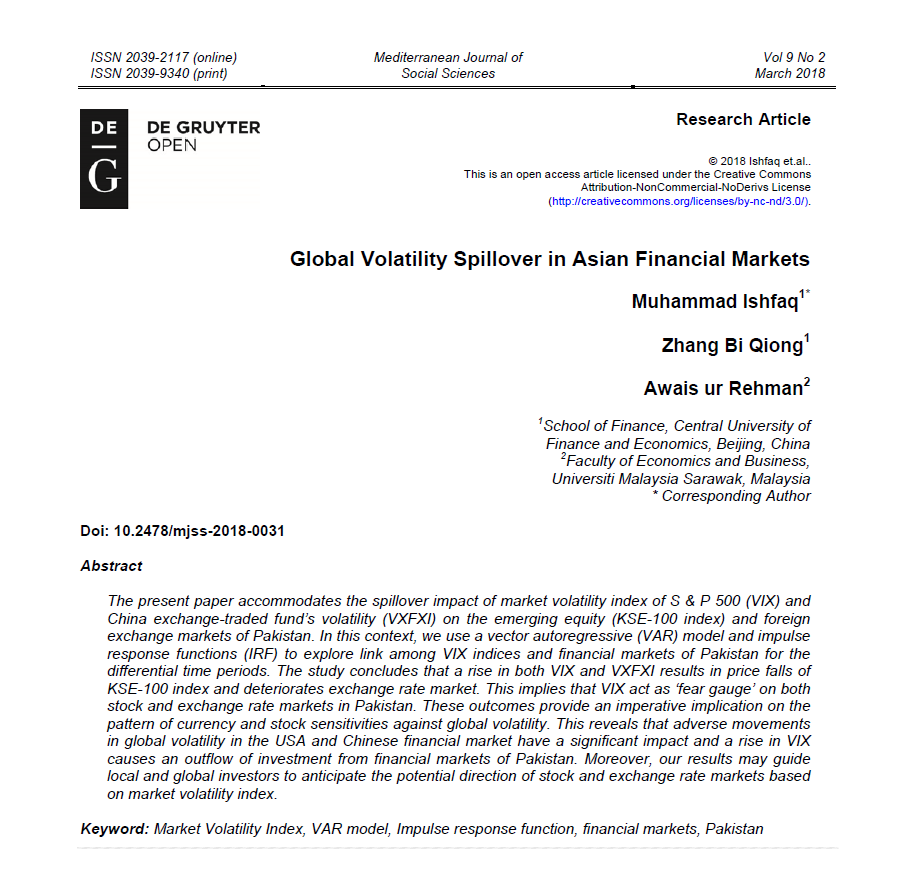
Chan WANG:Optimal Fiscal and Monetary Policy with Durable Goods
Chan WANG
Annals of Economics and Finance
VOL. 19-2, 2018, Pages 729–748
About the author

Chan WANG, assistant professor of the School of Finance at CUFE, Doctor of Economics. For more information, please visit this webpage: http://ensf.cufe.edu.cn/szdw/lecturer/105351.htm
Abstract:
In this paper, we examine the question of how to conduct fiscal and monetary policy in a two-sector Ramsey model with durable and non-durable goods. Due to the fact that the intertemporal elasticity of substitution of durable goods is much higher than that of non-durable goods, the introduction of durable goods changes the policy prescriptions substantially. Specifically, in comparison with the findings in the literature, we find that the labor income tax rate and the interest rate exhibit greater volatility. In addition, the volatilities of the labor income tax rate and the interest rate increase with the decrease in the depreciation rate of durable goods.
